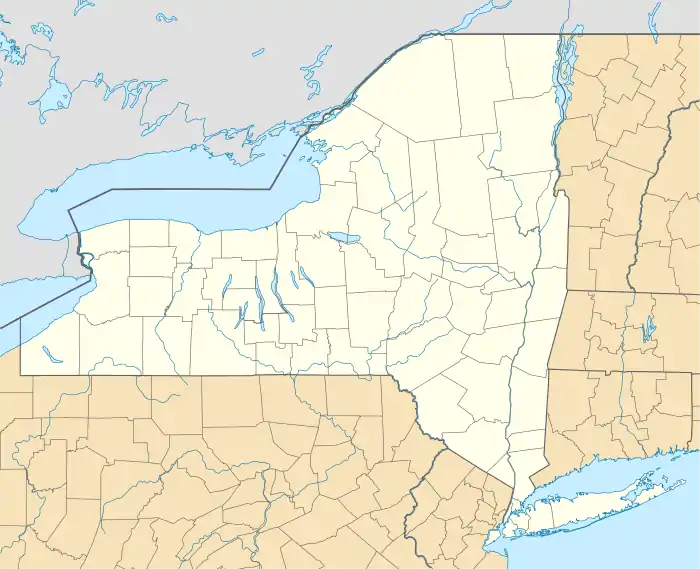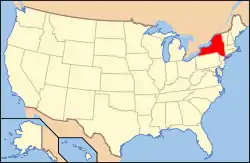Oak Hill (Linlithgo, New York)
Oak Hill is a historic estate located at Linlithgo in Columbia County, New York.
Oak Hill | |
  | |
| Nearest city | Linlithgo, New York |
|---|---|
| Coordinates | 42°12′0″N 73°50′40″W |
| Area | 200 acres (81 ha) |
| Built | 1795 |
| Architectural style | Colonial Revival, Greek Revival, Federal |
| NRHP reference No. | 79001573[1] |
| Added to NRHP | June 26, 1979 |
History
Oak Hill was built in 1793 by John Livingston,[2] the twelfth of thirteen children born to Robert Livingston, third lord of Livingston Manor, and his wife Maria Thong (1711–1765), the granddaughter of Governor Rip Van Dam.
John Livingston was born February 21, 1750 at Oak Hill in Greene County, New York. His father expected his sons to take their place as his business agents and, like his older brothers, John was educated accordingly. He engaged in land speculation on both sides of the Hudson.[3] In 1788, he served as aide-de-camp to Brigadier General George Clinton.[4]
In his will, Robert Livingston, who died in 1790, devised his land lying east of the Post Road to four of his sons, Walter, Robert C., Henry, and John, each receiving about 28,000 acres; each received also a part of the domain to the west of that road. Originally the land was covered with timber, principally pine and oak. John settled a little south of Johnstown, now known as Livingston, which was named after him, and there built the house afterwards occupied by Philip L. Hoffman, grandfather of the late Governor Hoffman; later it was the home of John's younger brother Hendrick "Henry" (1752–1823). After John sold that property to Mr. Hoffman he moved to Oak Hill. In 1787, John Livingston served as supervisor of the Town of Livingston.[5]
John Livingston married Maria Ann Leroy, daughter of Jacob Leroy and Cornelia Rutgers. His second wife was his first cousin, Catherine (Livingston) Ridley, the daughter of his uncle William Livingston, and the widow of Matthew Ridley. The wedding took place in November 1796 at Government House (New York City), the then residence of Governor John Jay,[6] who was married to Catherine's elder sister Sarah.[7] Livingston died at his Oak Hill estate at the age of seventy-two on October 24, 1822, and is buried in the Linlithgo Reformed Church Cemetery.
The home remains in the Livingston family and is used as a wedding venue.[7]
Description
John Livingston chose the northwest corner of Livingston Manor as the site for his house, and named it after his place of birth.
It is a 2 1⁄2-story, brick rectangular block with a smooth surface in the Federal style. Late-19th-century additions and alterations include the mansard roof and cornice, front porch, and kitchen wing. Also on the property are a carriage house (c. 1900), garage (c. 1924), two former equipment storage buildings (c. 1900), corncrib (c. 1900), and a small residence / carpentry shop (c. 1800). Also on the estate are a Colonial Revival style gatehouse (1900), the Caperus Cole house (1778) with later Greek Revival style details, a barn (1801), the Robert Evans house (c. 1890), Studley house (1780), and Gavigan house (c. 1890).[8]
It was added to the National Register of Historic Places in 1979.[1]
References
- "National Register Information System". National Register of Historic Places. National Park Service. March 13, 2009.
- Tarmy, James. "Inside the Hidden Lives of New York’s Last Aristocrats", Bloomberg, December 17, 2018
- "Livingston family papers", Archives at Yale
- Livingston, Edwin Brockhulst. The Livingstons of Livingston Manor, p. 228
 This article incorporates text from this source, which is in the public domain.
This article incorporates text from this source, which is in the public domain. - "History of Livingston, NY", Columbia County At The End of the Century, Hudson, New York. Hudson Gazette: The Record Printing and Publishing Co., 1900
 This article incorporates text from this source, which is in the public domain.
This article incorporates text from this source, which is in the public domain. - Reynolds, Cuyler. Genealogical and Family History of Southern New York and the Hudson River Valley, Lewis Historical Publishing Company, 1914
 This article incorporates text from this source, which is in the public domain.
This article incorporates text from this source, which is in the public domain. - "History", Livingston Weddings
- Jessica Kemm; Townley M. Sharp & L. Corwin Sharp (January 1979). "National Register of Historic Places Registration: Oak Hill". New York State Office of Parks, Recreation and Historic Preservation. Retrieved 2010-07-03. See also: "Accompanying photos and additional documentation".

